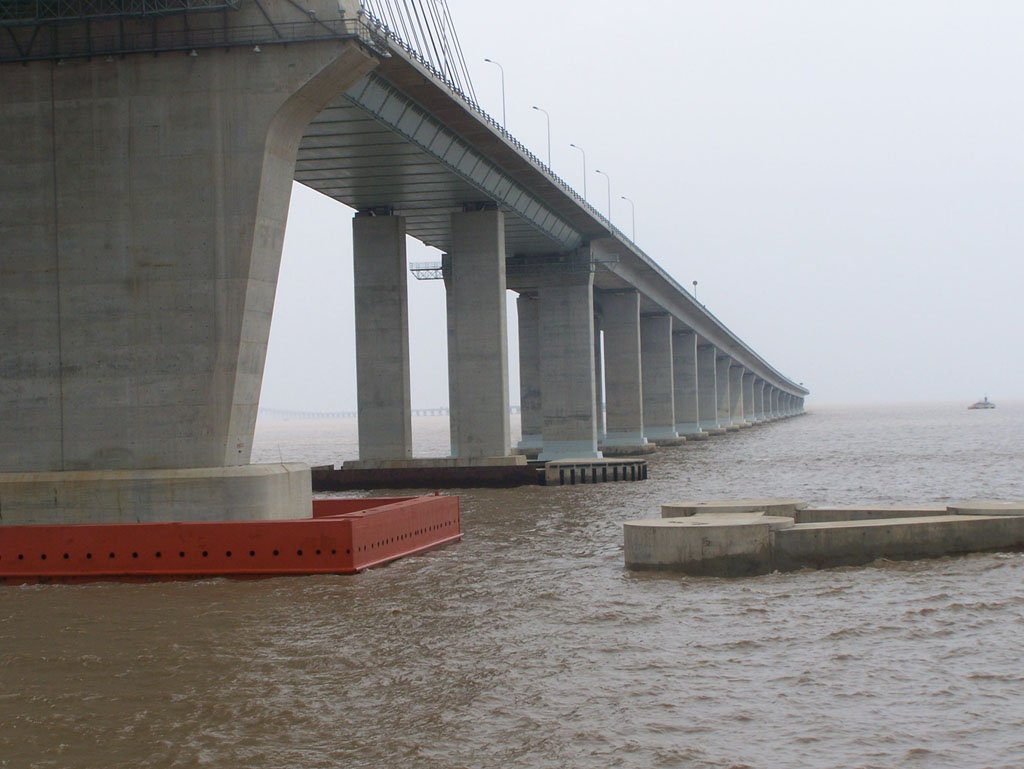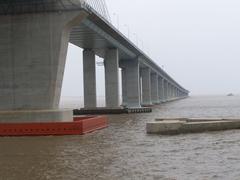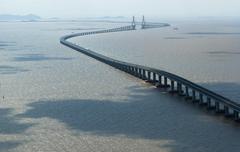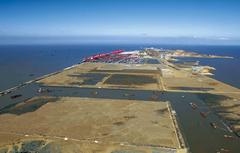
Donghai Bridge Visiting Hours, Tickets, and Travel Guide in Shanghai
Date: 14/06/2025
Introduction to Donghai Bridge in Shanghai
Spanning 32.5 kilometers across Hangzhou Bay, the Donghai Bridge (东海大桥) is a monumental achievement in modern infrastructure and a symbol of Shanghai’s emergence as a global maritime and logistics center. Connecting Shanghai’s Pudong New Area to the offshore Yangshan Deep-Water Port, this bridge is a critical artery for international trade and regional economic integration. Its S-shaped design, innovative engineering, and ability to withstand the East China Sea’s harsh marine environment make it an attraction for engineers, architecture enthusiasts, and travelers alike.
Although the bridge is exclusively for vehicular traffic—prohibiting pedestrians and cyclists—visitors can still appreciate its scale from designated viewpoints on both the mainland and Yangshan Island, or through organized boat tours. The area is further enriched by attractions such as the Yangshan Deep-Water Port, Shanghai Maritime Museum, and scenic coastal parks.
This guide provides a detailed overview of the Donghai Bridge, including its history, engineering highlights, practical visitor information, and travel tips to ensure a rewarding experience. For academic insights and further reading, see references such as the Journal of Transport Geography and specialized transportation literature. (Donghai Bridge Shanghai: Visiting Hours, Tickets, and Historical Insights)
Contents Overview
- Introduction
- Historical Background
- Significance in Regional Development
- Technological and Engineering Achievements
- Visiting Donghai Bridge: Practical Information
- Key Attractions and Photo Opportunities
- Yangshan Island: Gateway to Maritime Exploration
- Visitor Logistics and Transportation
- Nearby Attractions and Amenities
- Insider Tips for a Memorable Visit
- Frequently Asked Questions
- Visuals and Media
- Related Articles
- Summary and Final Tips
- Sources and Further Reading
Historical Background
Conception and Strategic Vision
The Donghai Bridge was envisioned in the late 1990s as a strategic component of Shanghai’s transformation into a world-class shipping and logistics hub. The existing port facilities struggled with shallow waters and congestion, limiting their ability to accommodate the ever-growing size of modern cargo vessels. As a solution, the Yangshan Deep-Water Port project was launched, with the Donghai Bridge serving as the vital link between this offshore port and the mainland.
Planning, Design, and Construction
Planning began with rigorous feasibility studies that addressed environmental, technical, and economic challenges. The bridge’s cable-stayed design—featuring a 420-meter main span—was selected to allow for large ships to pass beneath. Construction commenced in June 2002, involving over 7,000 workers and advanced technologies such as high-durability concrete, anti-corrosion methods, and deep foundations exceeding 70 meters. The bridge opened to traffic in December 2005, ahead of schedule.
Significance in Regional Development
The Donghai Bridge enabled the rapid expansion of Yangshan Deep-Water Port, which quickly rose to become the world’s busiest container port by 2010. The bridge’s seamless connection to Shanghai’s expressway network has facilitated efficient cargo movement, integrated hinterland logistics, and spurred economic growth in the Yangtze River Delta region.
Technological and Engineering Achievements
At its inauguration, Donghai Bridge was the longest sea-crossing bridge globally. Its construction showcased Chinese engineering ingenuity, utilizing GPS-guided assembly, real-time structural monitoring, and marine environment-resistant materials. The S-shaped alignment not only enhances stability against typhoons and seismic activity but also adds to its visual appeal. (China Top Trip)
Visiting Donghai Bridge: Practical Information
Visiting Hours
- Vehicular Access: 24 hours a day, all year round.
- Pedestrian & Bicycle Access: Not permitted for safety reasons.
Tickets and Fees
- Vehicles: Toll fees apply; rates vary by vehicle type.
- Pedestrians: No ticketing, as access is restricted.
- Tours: Guided boat tours and sightseeing experiences can be booked via local operators.
How to Get There
- By Car: Direct access from Shanghai’s expressway system.
- Public Transport: Shuttle buses and tour buses operate between Shanghai and Yangshan Port.
- To Viewing Points: Use taxis, buses, or organized tours to reach observation platforms in the Pudong district or on Yangshan Island.
Accessibility
The bridge accommodates heavy commercial traffic and is not designed for non-vehicular access. Viewing areas near Luchao Harbor and on Yangshan Island provide safe and scenic vantage points for visitors.
Key Attractions and Photo Opportunities
- Yangshan Deep-Water Port: Observe operations at one of the world’s busiest container ports.
- Observation Decks: Platforms near Luchao Harbor and Yangshan Island deliver panoramic views of the bridge’s sweeping S-shape and bustling maritime activity.
- Scenic Lookouts: Coastal parks and elevated spots are ideal for photography, especially during sunrise and sunset. (Top China Travel)
Yangshan Island: Gateway to Maritime Exploration
At the southern end of the bridge, Yangshan Island is both a critical logistics hub and a destination in its own right. While the deep-water port is not generally open to the public, the island offers:
- Yangshan Fishing Village: Experience local seafood and maritime culture.
- Coastal Trails and Lookouts: Enjoy panoramic views of the bridge, port, and surrounding seascape.
- Boat Tours and Excursions: Local operators offer sightseeing and fishing trips. (Top China Travel)
Visitor Logistics and Transportation
- By Car: The most convenient way to reach observation points and access the bridge.
- Public Transport: No direct metro or bus crosses the bridge; consider hiring a car or joining a guided tour.
- Tolls and Speed Limits: Toll fees apply; speed limit is 80 km/h (50 mph); stopping on the bridge is prohibited.
- Best Seasons: Spring and autumn offer the best weather and visibility; typhoon season (July–September) may affect access. (China Top Trip)
Nearby Attractions and Amenities
- Luchao Harbor: Home to seafood restaurants, parks, and observation areas.
- Shengsi Islands: A scenic archipelago with hiking, beaches, and local food.
- Liuhe Chaoyang Scenic Area & Heshangtao Scenic Spot: Options for nature and cultural exploration. (Trip.com, OrangeSmile)
Insider Tips for a Memorable Visit
- Photography: Sunrise and sunset offer the best lighting; a telephoto lens is recommended.
- Weather: Check forecasts, especially during typhoon season.
- Guided Tours: Enhance your visit with historical and technical insights.
- Dining: Try local seafood at Luchao Harbor or Yangshan Island.
- Accommodation: Overnight stays are possible on Yangshan Island or in Pudong for a more relaxed experience. (OrangeSmile)
Frequently Asked Questions
Can I walk or cycle across the Donghai Bridge?
No, only motor vehicles are allowed for safety reasons. (China Top Trip)
Are there observation decks on the bridge?
No, but viewing platforms are available near both bridge termini. (Top China Travel)
What are the Donghai Bridge visiting hours?
Open to vehicles 24/7; daylight hours are best for sightseeing.
Are tickets required to visit Donghai Bridge?
No tickets for pedestrians; tolls apply for motor vehicles.
What is the purpose of the bridge’s S-shape?
It enhances structural stability and safety during typhoons and high seas. (China Top Trip)
How long does it take to cross the bridge?
Crossing at the speed limit takes about 25–30 minutes depending on traffic.
Visuals and Media
For a richer experience, explore online galleries and virtual tours that showcase the Donghai Bridge’s panoramic views, S-shaped curves, and engineering details. Interactive maps and high-resolution images can help you visualize routes and plan your itinerary.
Related Articles
Summary and Final Tips for Visiting Donghai Bridge
The Donghai Bridge is a testament to Shanghai’s ambition and China’s engineering excellence, fundamentally transforming regional logistics and connectivity. While the bridge itself remains closed to pedestrians, its impressive scale can be appreciated from nearby observation points, guided tours, and boat excursions. Whether you are a fan of engineering, maritime history, or simply seeking unique photographic opportunities, the Donghai Bridge is a highlight of Shanghai’s modern landscape.
Plan your visit for clear days and daylight hours, explore nearby attractions such as Yangshan Island, and enhance your experience with guided tours for a deeper understanding of the bridge’s strategic and technological significance. For the latest visitor updates, travel tips, and guided tour arrangements, download the Audiala app and follow official channels.
Sources and Further Reading
- Journal of Transport Geography
- China Top Trip. Donghai Bridge.
- Top China Travel. Shanghai Donghai Bridge.
- Trip.com. Donghai Bridge Travel Guide.
- OrangeSmile. Donghai Bridge.
























































































